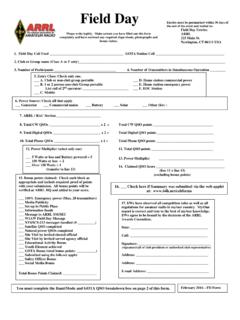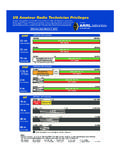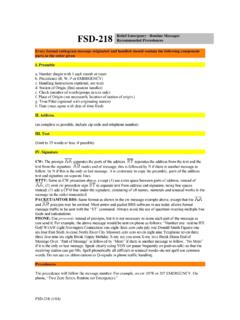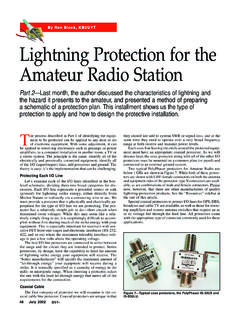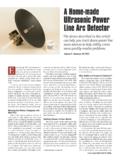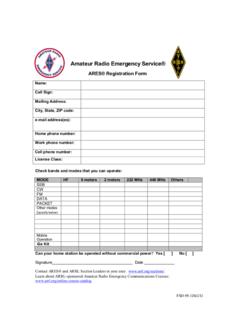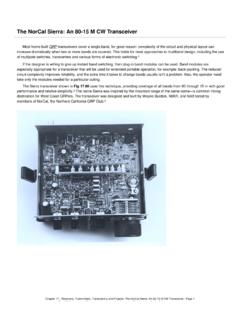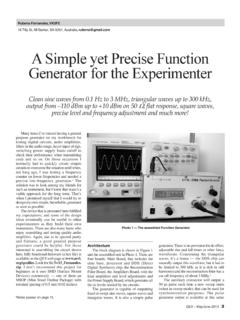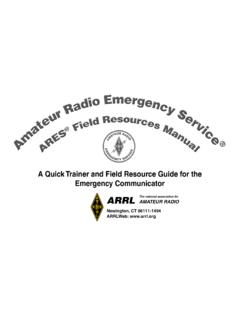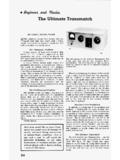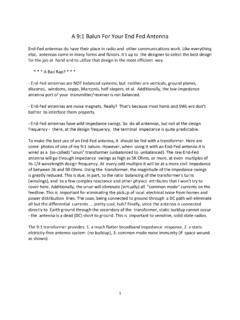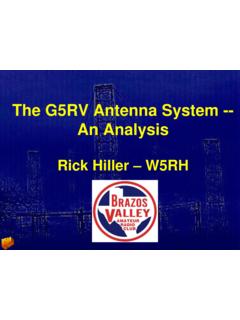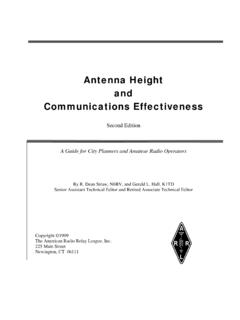Transcription of Choosing a Ham Radio - American Radio Relay League
1 Choosing a Ham Radio your guide to selecting the right equipment Lead Author Ward Silver, N AX;. Co-authors Greg Widin, K GW and David Haycock, KI6 AWR. About This Publication Types of Operation VHF/UHF Equipment WHO NEEDS THIS PUBLICATION AND WHY? HF Equipment Hello and welcome to this handy guide to selecting a Radio . Choos- ing just one from the variety of Radio models is a challenge! The Manufacturer's Directory good news is that most commercially manufactured Amateur Radio equipment performs the basics very well, so you shouldn't be overly concerned about a wrong choice of brands or models. This guide is intended to help you make sense of common features and decide which are most important to you.
2 We provide explanations and defini- tions, along with what a particular feature might mean to you on the air. This publication is aimed at the new Technician licensee ready to acquire a first Radio , a licensee recently upgraded to General Class and wanting to explore HF, or someone getting back into ham Radio after a period of inactivity. A technical background is not needed to understand the material. ABOUT THIS PUBLICATION. After this introduction and a Quick Start guide, there are two main sections; one cov- ering gear for the VHF and UHF bands and one for HF band equipment. You'll encounter a number of terms and abbreviations watch for italicized words so two glossaries are provided; one for the VHF/UHF section and one for the HF section.
3 You'll be comfortable with these terms by the time you've finished reading! We assume that you'll be buying commercial equipment and accessories as new gear. Used equipment is cheaper, of course, but may have faults or defects with which you might be unfamiliar, leading to problems. Teaming up with an experienced ham or a reputable dealer is the way to evaluate used equipment. Unless you are experienced with electronics, kits and homebuilt rigs are not recommended as a first Radio , either. Websites of some Radio manufacturers are listed at the end of this document. What This Publication Is Not This isn't a traditional buyer's guide with feature lists and prices for many radios. Manufacturer's websites and catalogs from Radio stores have plenty of information on the latest models and features.
4 You won't find operating instructions or technical specifications here download brochures and manuals directly from the manufacturer! your Best Resource your best resource is a knowledgeable friend. Better yet, how about a group of friends? This is where a ham Radio club or team can really help. Find local clubs via the ARRL's home page: enter Clubs in the site's search window. A club can help you with every aspect of Choosing a Radio ; from explaining a feature to filling you in on Choosing a Ham Radio 1. what works best in your area. These helpful Elmers (ham Radio mentors) may be willing to loan or demonstrate a Radio so you can experience different styles of operating before making buying decisions.
5 If the group is supporting a public-service activity, such as a walkathon, parade, or race, volunteer to help so you can see how the radios are actually used. The Choosing a Ham Radio Website It's not possible to give you all the details in one publication, so a supporting web page has been created at It is referenced on a web page for new hams that includes handy references to download and print, supplements that will be updated, and links to a more complete glossary and other online resources and books to help you learn even more. NEW TO HAM Radio ? If you are new to ham Radio with a background in other types of Radio communica- tions, you should read the supplement Ham Ways A Primer available on the Buy- ing your First Radio web page listed in the preceding paragraph.
6 It will explain some of the ways hams communicate that may be unfamiliar. This will help you understand more about ham Radio features and why they are important to hams. ARE YOU READY? Finally, savor the experience you'll never buy another first Radio , so have fun! If things don't turn out exactly as you expect, you can easily sell or trade for different equip- ment. Most hams try many radios and you probably will, too. So relax and prepare to enjoy the ride! Once you're finished, others can use this publication, too. Give it away or tell them about this guide's website where they can download and print their own copy! CONTRIBUTORS. The following Elmers contributed by reviewing this publication to make it as use- ful as possible, their way of giving back to ham Radio : Norm, K6 YXH; Ken, WA3KD.
7 Dave, KA1 HDG; Mike, N4 FOZ; James, KG8DZ; Jason, KI6 PCN; Barb, N6 DNI; Pat- rick, KI6 PCS; Ken, WD9 DPK; Mary, KI6 TOS; Paula, KI6 SAK; Jack, AD7NK; Katie, W1 KRB; Sharon, KE7 HBZ; Matt, N8MS; Marty, N6VI; Diane, KE7 PCS; Charles, KE4 SKY and Chris, KB7 YOU. WHAT DO YOU WANT TO DO? Answering that question starts with the type of activities that interest you, such as emer- gency communications, casual conversation with friends or club members, or communi- cating using digital data. You'll need to then consider the range over which you expect to make contacts and the type of station you expect to use. Table 1. Where Are The Hams You Want To Contact? Bands and Typical Distances Range Bands Considering how Radio waves of different frequencies propagate (travel) helps answer the question of what bands Nearby VHF/UHF.
8 your Radio will need. Different bands support different Regional VHF/UHF (via repeaters). ranges of contacts as shown in Table 1. Evaluate the ac- and HF (direct contact). tivities in which you want to participate to see where you Country-wide HF. will need to make contacts. (Glossaries in the Ham Radio World-wide HF (direct contact), License Manual or on-line at explain these VHF/UHF (Internet links). and many other terms.). 2 Choosing a Ham Radio Quick Start: Common Profiles You may find it useful to start with one of our four common ham profiles . your operating needs could be similar to one of them. Once you choose a profile, fill in the details by reading the VHF/UHF or HF sections that follow for details on the various features and functions.
9 Download the comparison form from the Buying your First Radio web page to organize your shopping list. Consult local hams to find out what bands are used most commonly. For example, in more sparsely populated areas, the 70 cm band may not be in widespread use. In other areas, another VHF or UHF band such as 222 MHz may be in regular use. Emergency Communication Team Member or Personal Emergency Communications For operation through easily accessible repeaters or over very short ranges, you'll need a VHF/UHF (dual-band) handheld Radio with at least 50 memories and 3 to 5 watts of output power. A spare rechargeable battery pack, a pack that holds AA or AAA batteries, an automotive adapter, and a desktop quick-charger are must-have accessories.
10 For operation without repeaters or through distant repeaters while mobile or in remote areas, add a VHF/UHF mobile Radio with an output of 25 watts or more and a dual-band quarter-wave mobile whip antenna . Many hams have one of each type of Radio . Beginning Home HF Operation HF transceivers with 100 watts of output and a built-in antenna tuner make an excellent entry-level Radio . HF radios with VHF and even UHF coverage are available at higher cost. If the Radio can't operate directly from ac power you'll need an external dc power supply. A multi-band dipole is an excellent and inexpensive antenna , connected to the Radio through coaxial cable or open-wire feed line the latter will require an external antenna tuner.
